Musculoskeletal Applications
Musculoskeletal disorder patients have intact proprioception, our sense of our body's position and movement. Musculoskeletal biofeedback applications include blepharospasm, erectile dysfunction, fecal elimination disorders, functional constipation, urinary incontinence, meniscectomy, and muscle-tendon transfers.
Since the publication of Evidence-Based Practice in the Biofeedback and Neurofeedback (3rd ed.), several RCTs have provided stronger evidence of the efficacy of two disorders covered in this unit. Specifically, erectile dysfunction and urinary incontience for men and women now warrant a level-5 rating of efficacious and specific. Pediatric urinary incontinence is a candidate for a level-4 rating of efficacious.
A meniscectomy (removal of knee cartilage) illustrates a musculoskeletal intervention. These patients may show generalized muscular weakness following surgery due to cartilage and ligament damage. A physical therapist may use electromyographic biofeedback to increase motor unit recruitment (number of motor units and their firing rate) to restore strength and function.
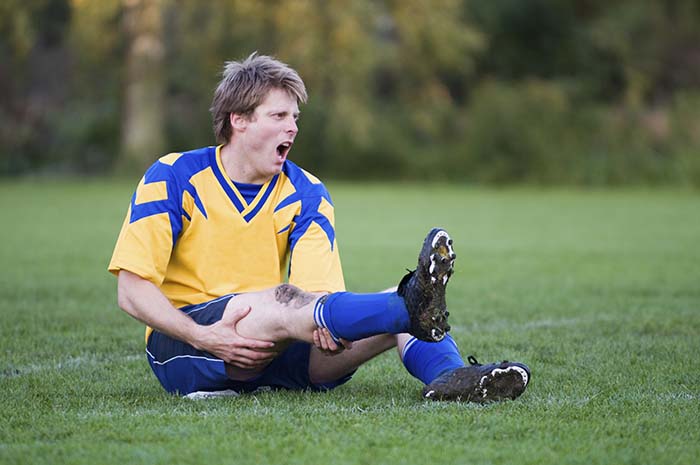
BCIA Blueprint Coverage
This unit addresses General treatment considerations (IV-D) and Target muscles, typical electrode placements, and SEMG treatment protocols for specific neuromuscular conditions (IV-E).

This unit covers Blepharospasm, Erectile Dysfunction, Fecal Elimination Disorders, Functional Constipation, Urinary Incontinence, Meniscectomy, and Muscle Tendon Transfer.
Please click on the podcast icon below to hear a full-length lecture.

EVIDENCE-BASED PRACTICE (4TH ED.)
We have updated the efficacy ratings for clinical applications covered in AAPB's Evidence-Based Practice in Biofeedback and Neurofeedback (4th ed.).
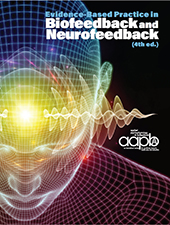
BLEPHAROSPASM
Blepharospasm involves involuntary spasms of both eyelids characterized by bilateral blinking, usually found in elderly patients. These spasms may be isolated or may affect associated facial muscles (Gibbons & Engstrom, 2018).
Listen to a mini-lecture on Blepharospasm © BioSource Software LLC.
The responsible muscles are the orbicularis oculi that surround the eyes. Symptoms range in severity from increased blinking and periodic eyelid spasm to ocular pain, facial spasms, and disabling interference with vision. Their functional blindness may prevent normal activities that depend on sight, like driving, reading, viewing television, and walking. Anxiety, depression, suicide, inability to perform their job, and social withdrawal are common reactions.
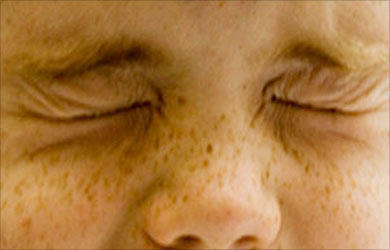
Demographics
There are an estimated 50,000 cases of blepharospasm in the United States, with 2,000 new cases annually and a prevalence of 5 in 100,000. This disorder is more common in women than men (1.8 to 1). Blepharospasm is first diagnosed at 56, and two-thirds of these patients are 60 or older (Graham, 2014).Biofeedback Protocols
SEMG biofeedback can be used to reduce spasticity in the orbicularis oculi muscles. Miniature (0.5 cm) surface electrodes are placed over these muscles. Clinicians instruct clients to reduce the elevated SEMG levels associated with muscle hyperactivity. Home practice may focus on spasm suppression using a mirror for feedback.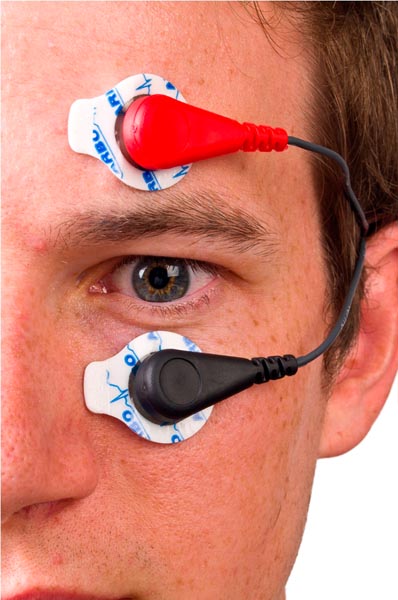
The orbicularis oculi muscles (shown below) are located around the eyes.
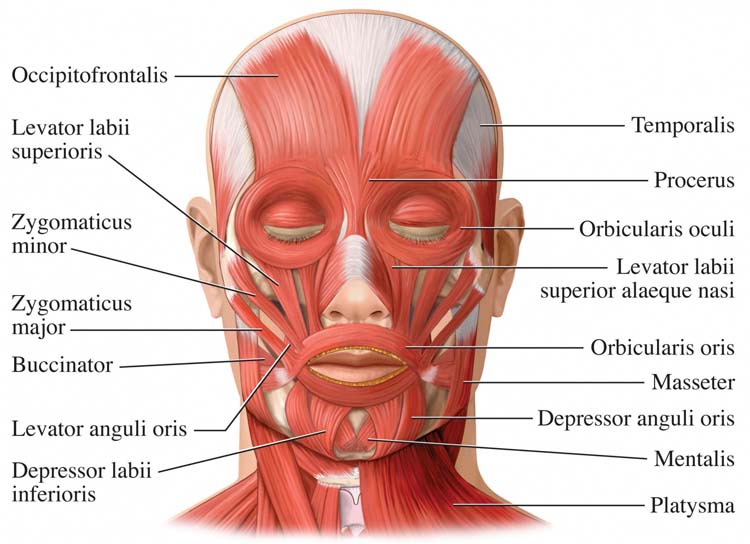
Below is a BioGraph ® Infiniti display that provides SEMG biofeedback to help clients learn to relax.
Clinical Efficacy
Evidence-Based Practice in Biofeedback and Neurofeedback (4th ed.) did not evaluate this application.Erectile Dysfunction
Erectile dysfunction (ED) refers to the inability to sufficiently achieve or sustain a penile erection for sexual intercourse (Shamloul & Ghanem, 2013). The etiology for ED can be neurogenic, psychogenic, endocrinologic, or iatrogenic. A cross-sectional epidemiological study in the USA found that as many as 18.4% of men over 20 years may experience ED (Selvin et al., 2007). Several studies support higher prevalence rates of ED among those with diabetes, hypertension, and major depression (e.g., Seftel et al., 2004).
ED can also be the consequence of surgery despite the advanced techniques developed to preserve the integrity of the nerves responsible for regulating erections (Burnett et al., 2007). Radical prostatectomy, a common surgical procedure for localized prostate cancer, causes ED in 26-100% of patients (Burnett et al., 2007; Walsh et al., 1987) due to neurovascular bundle injury and other mechanisms (Dubbelman et al., 2006). Graphic © Elen Bushe/Shutterstock.com.

Demographics
Radical prostatectomy (RP) is a common surgical procedure for localized prostate cancer. It causes erectile dysfunction (ED) in 26-100% of patients (Burnett et al., 2007; Walsh et al., 1987) due to neurovascular bundle injury and other mechanisms (Dubbelman et al., 2006). The National Health and Social Life Survey (NHSLS) reported that 10.4% of men aged 18-59 experienced ED during the previous year (Benet et al., 1995). Graphic © joshya/Shutterstock.com.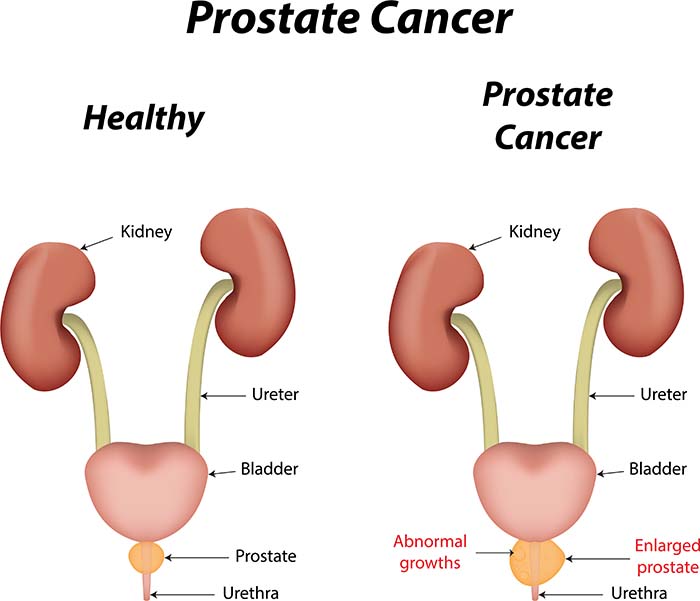
The etiology of non-iatrogenic ED (not due to medical treatment) is complex and poorly understood. In men, the ischiocavernosus muscle (ICM) and bulbospongiosus pelvic-floor muscle are active during sexual intercourse. Contraction of the ICM produces rigidity during the muscular phase of erection.

Biofeedback Procedures
An impressive and growing body of research, including several randomized controlled trials (RCTs), has shown encouraging results for pelvic-floor biofeedback training (PFBT) that combines pelvic floor muscle exercises, EMG biofeedback, and electrical stimulation.Successful randomized controlled trials treated erectile dysfunction with multiple components: electrical stimulation of perineal muscles, EMG biofeedback of pelvic-muscle activity, lifestyle advice, and pelvic floor muscle exercises.
Click on the Read More button to see research study summaries.
Van Kampen and colleagues (2003) evaluated the effectiveness of pelvic-floor exercises, electromyographic (EMG) biofeedback of pelvic floor muscle activity, and electrical stimulation of perineal muscles for ED using a pretest/posttest design. Fifty-two patients received 4 months of weekly PFBT training sessions administered by a physical therapist. After participants completed training, 47% achieved a normal erection, 24% improved, and 12% did not change.
Dorey and colleagues (2004, 2005) reported a randomized controlled trial (RCT) for 55 men diagnosed with ED. The researchers randomly assigned 28 patients to a PFBT intervention group, which received pelvic-floor muscle exercises, biofeedback, and recommendations for lifestyle changes, and 27 patients to a control group, which only received lifestyle counseling. After 3 months, the intervention group achieved better erectile function than the control group.
Sighinolfi and colleagues (2009) evaluated a case series of three RP patients treated with 4 months of weekly sessions of PFBT. These sessions combined exercises to strengthen pelvic-floor muscles, EMG biofeedback, electrical stimulation, lifestyle advice, and home practice of pelvic-floor muscle contractions without feedback. Following training, all three patients improved erectile function.
Prota and colleagues (2012) reported a RCT of PFBT for ED following RP. The experimental group (n = 26) received once-weekly 30-minute PFBT using EMG biofeedback with an electrode inserted within the anus and on the ankle and home exercises for 3 months. The control group (n = 26) only received verbal directions to guide pelvic floor contraction. Twelve months following RP, more experimental subjects (47%) than control subjects (12.5%) recovered potency.
Lavoisier and colleagues (2014) conducted an observational historical cohort study of 122 men diagnosed with isolated ED and 108 men diagnosed with isolated premature ejaculation (PE). Intercavernous pressure (ICP) indexes vascular pressure within the penis. The maximum change in ICP increased (87% and 88%, respectively) for ED and PE patients with positive trends. The maximum ICP baseline also increased (99% and 72%, respectively) for ED and PE patients with positive trends.
Clinical Efficacy
Meehan and Shaffer (2023) rated EMG biofeedback as efficacious and specific for treating ED. Two independent RCTs, one for participants after RP (Prota et al., 2012) and one for non-iatrogenic ED (Dorey et al., 2004, 2005), demonstrated that interventions that combine pelvic-floor muscle exercises, EMG biofeedback, and electrical stimulation could restore or improve erectile function. These RCTs found that the investigational treatment was statistically superior to alternative bona fide treatments (pelvic floor contraction exercises and lifestyle counseling). The studies were conducted in independent research settings.FECAL ELIMINATION DISORDERS
Fecal incontinence is the involuntary release of feces or gas due to loss of anal sphincter control.
Listen to a mini-lecture on Fecal Elimination Disorders © BioSource Software LLC.
The diverse causes of fecal incontinence include congenital abnormalities that damage the spinal cord, and anal sphincter damage due to vaginal delivery, surgery, inflammatory conditions, cancer, and inflammatory bowel conditions. Medical conditions, including diabetes mellitus, stroke, spinal cord trauma, and neurodegenerative disorders, may also contribute to incontinence (Ranganath, 2012). Graphic © SciePro/Shutterstock.com.
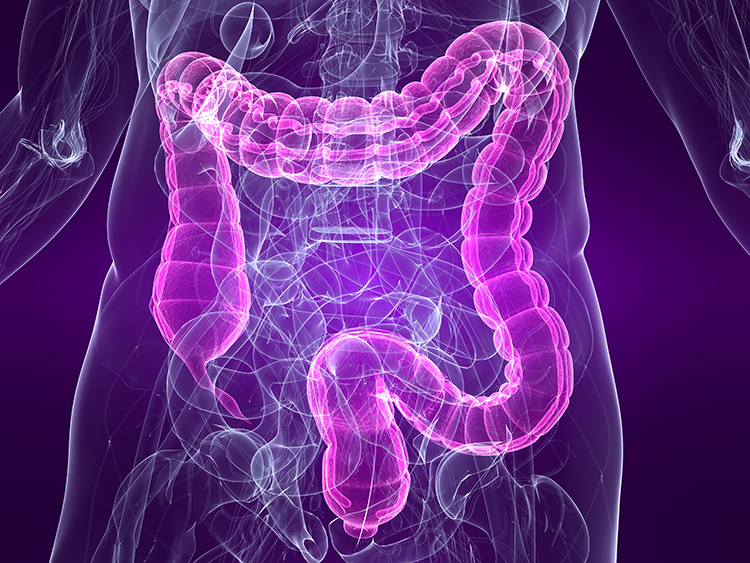
Demographics
The prevalence of fecal incontinence is 2-3%. Childbirth is the most common predisposing factor to fecal incontinence because it may disrupt the internal or external anal sphincter or damage the pudendal nerve (Ranganath, 2012).Anatomy and Physiology
When peristalsis transports fecal material from the sigmoid colon to the rectum, pressure on the rectal wall triggers a defecation reflex. The firing of sacral spine parasympathetic motor neurons shortens the rectum, increasing pressure on fecal material.Increased pressure within the rectum opens the involuntary internal sphincter, voluntary diaphragm and abdominal muscle contraction, and parasympathetic stimulation. Intentional relaxation of the voluntary external sphincter expels feces, while constriction postpones defecation (Seymour, 2002). Graphic © Designua/Shutterstock.com. defecation (Seymour, 2002). Graphic © Designua/Shutterstock.com.
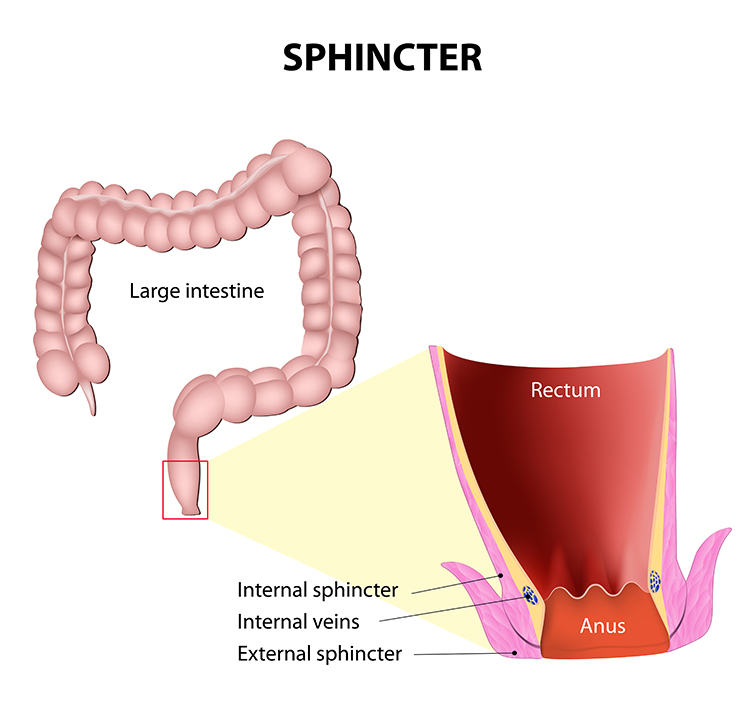
Biofeedback Protocols
Biofeedback should only be initiated following medical evaluation and conducted under medical supervision. The primary biofeedback modalities used to treat fecal incontinence are balloon manometers, electromyographs, and ultrasound. Clinicians design treatment protocols to increase rectal sensitivity, perianal muscle strength, and coordination between the internal and external anal sphincters (Norton & Cody, 2012).The MindMedia anal EMG probe below detects muscle activity associated with the external anal sphincter.
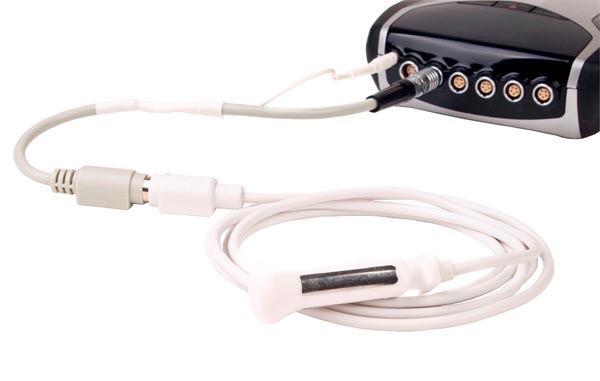
Continence training teaches the patient to increase external rectal sphincter strength to prevent unwanted voiding of feces and develop proprioceptive cues so that signals from rectal wall stretch receptors will contract the external rectal sphincter to avoid leakage.
A manometry system (shown below) places one of three balloons (Schuster anorectal probe or others) in the anal canal to simulate the movement of fecal material, adjacent to the internal rectal sphincter, and adjacent to the external rectal sphincter. As the anal canal balloon is inflated, polygraph tracings show contractions of the internal and external rectal sphincters. Training is designed to teach the patient to contract the external rectal sphincter (preventing leakage of feces) when the anal canal balloon expands, activating rectal wall stretch receptors.
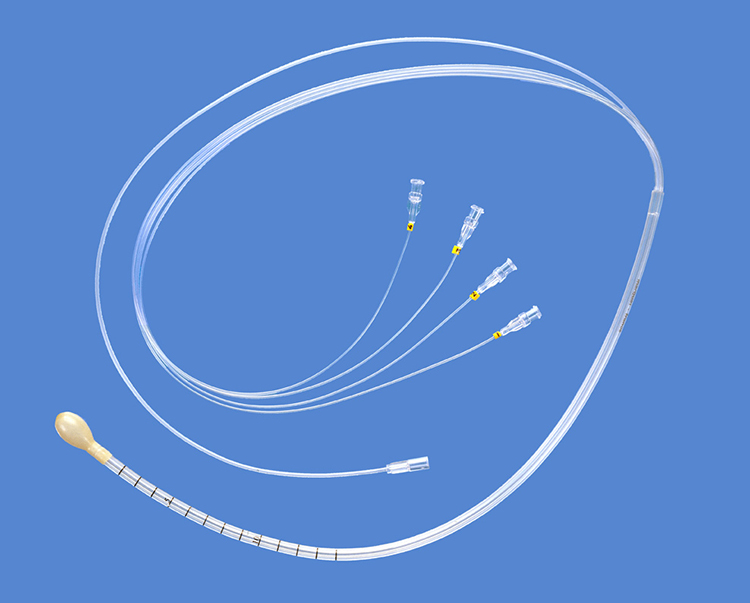
The transanal ultrasound system (below) allows physicians and patients to visualize the anal canal.
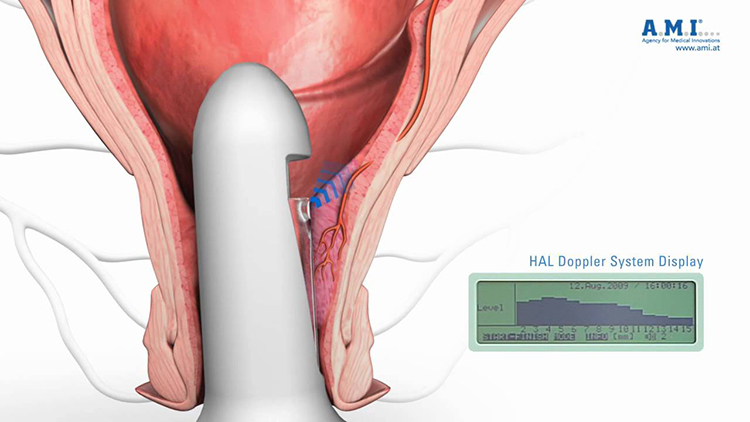
Adjunctive training procedures used in addition to biofeedback include bowel or habit training, dietary counseling, medication, home program including logs (regular bowel movements and incontinence episodes), and daily sphincter control exercises.
Biofeedback has been effective in children diagnosed with fecal incontinence and encopresis (constipation) and in adults with chronic fecal incontinence and incontinence due to obstetric complications and constipation. Several researchers have shown that patients maintain continence at long-term follow-up. Biofeedback does not correct incontinence caused by surgery to correct rectal prolapse.
Clinical Efficacy
Fecal Disorders in ChildrenEvidence-Based Practice in Biofeedback and Neurofeedback (4th ed.) did not evaluate biofeedback efficacy for fecal elimination disorders in children.
Biofeedback for fecal incontinence following anorectal surgery to correct malformations has produced clinical gains in several studies (Leung et al., 2006) despite a Cochrane Systematic Review (Brazzelli & Griffiths, 2006) that found no benefit to combining biofeedback with conventional treatment. Several studies (Iwai et al., 1997; van Ginkel et al., 2000) found improvement in constipation for 44-80% of the children studied.
Fecal Incontinence in Adults
Teo (2016) rated biofeedback for fecal incontinence in adults as level 4 - efficacious in Evidence-Based Practice in Biofeedback and Neurofeedback (3rd ed.).
Biofeedback for chronic fecal incontinence and incontinence due to childbirth and anorectal surgery has helped 60-92% of clients.
Vonthein et al. (2013) conducted a meta-analysis that showed that different biofeedback interventions produced remission rates that ranged from 20-54%. They found that continence rates doubled when biofeedback was combined with electrical stimulation. Meta-analyses by Enck et al. (2009) and Norman and Cody (2012) found that biofeedback modalities produced equivalent outcomes.
Solomon et al. (2013) conducted a randomized controlled trial of 120 patients using anal manometry, transanal ultrasound, and digital feedback during pelvic floor exercises. Seventy percent of these patients increased continence, and there were no group differences.
FUNCTIONAL CONSTIPATION
Functional constipation involves the abnormally slow movement of fecal material through the colon and difficulty in stool evacuation (Gilliland, 1997).
Listen to a mini-lecture on Functional Constipation © BioSource Software LLC.
Graphic © B-D-S Piotr Marcinski/Shutterstock.com.
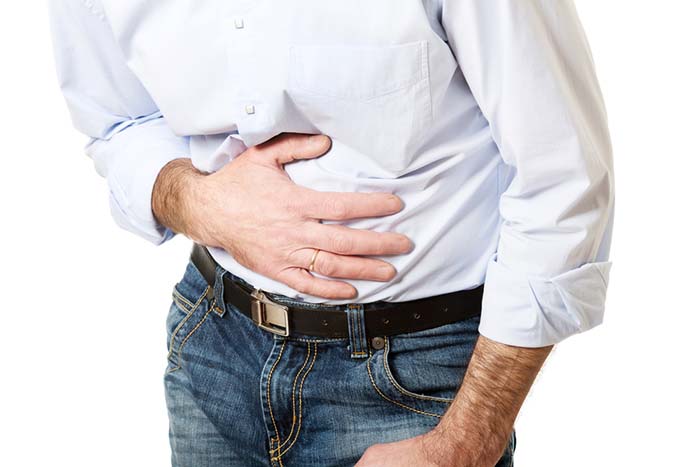
Anatomy and Physiology
The slow movement of feces, called slow transit constipation, can be caused by chronic laxative abuse, inadequate dietary fiber and fluid consumption, and excessive alcohol or caffeine (Basson, 2015). Problems evacuating stools, termed dyssynergic defecation, may be produced by dysfunctional anal contraction/relaxation or insufficient effort (Bleijenberg, 1994; Gilliland, 1997). Graphic © joshya/Shutterstock.com.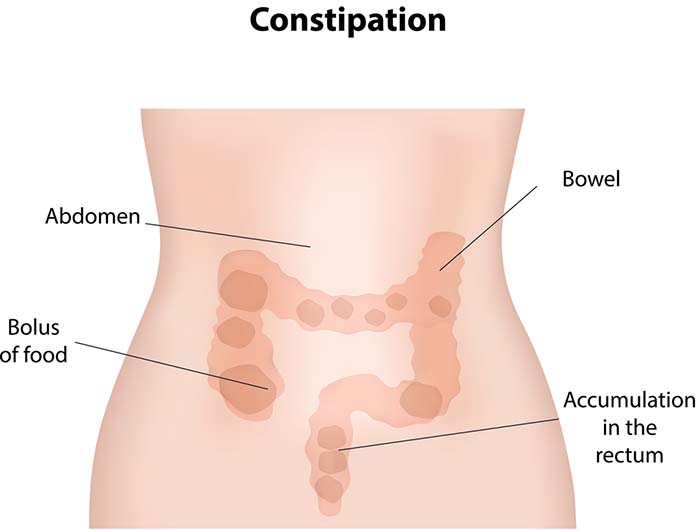
Demographics
Chronic constipation affects about 15% of Americans, and about 2% report constant or frequent episodes (Basson, 2015).Biofeedback Protocols
Clinicians have treated chronic constipation with EMG biofeedback, manometric biofeedback, and sensory training (Bassoti, 2004).Clinical Efficacy
Teo (2016) rated biofeedback for chronic constipation as level 4 - efficacious in Evidence-Based Practice in Biofeedback and Neurofeedback (3rd ed.).Biofeedback is superior to treatment as usual (TAU), including laxatives and patient education, but it has not been consistently better than new surgical interventions. Biofeedback appears more effective for correcting difficulty in evacuating stools than the slow movement of feces. While the strongest support is for EMG biofeedback, no single form of biofeedback is superior to the others (Woodward, Norton, & Chiarelli, 2014).
URINARY INCONTINENCE
Urinary incontinence (UI) is the involuntary loss of urine.
This problem affects approximately 13 million Americans, mainly women. Four common types of incontinence are urge incontinence, stress incontinence, mixed incontinence, and overflow incontinence.

Graphic © diy13/Shutterstock.com.

Urge incontinence involves involuntarily emptying the entire bladder. It is produced by detrusor muscle overactivity due to detrusor myopathy (an abnormal muscle condition), neuropathy (nerve damage), and both myopathy and neuropathy.
Stress incontinence is the involuntary loss of a variable amount of urine when intra-abdominal pressure increases. The problem in stress incontinence is the failure of the urethral sphincters to resist urinary flow. Possible stress incontinence causes include excessive urethral movement due to insufficient pelvic floor support and intrinsic sphincter deficiency.
Mixed incontinence is the involuntary loss of urine that results from stress and urge incontinence. The detrusor is overactive, and the urinary sphincters are weak (Vasavada, 2014).
Overflow incontinence is caused by urethral blockage. Graphic © medicalstocks/shutterstock.com.

Demographics
About 10-13 million Americans may experience UI. This disorder is twice as common in women as men. Urinary incontinence is the primary cause of nursing home admission when it overwhelms families who attempt to care for the relative at home (Vasavada, 2014).Anatomy and Physiology
The urinary bladder is located in the pelvic cavity. The bladder wall consists of three coats. The intermediate coat is the detrusor muscle, composed of three smooth muscle layers. The movement of urine from the urinary bladder to the urethral orifice is controlled by the involuntary internal urethral sphincter (smooth muscle) and voluntary external urethral sphincter (skeletal muscle).Micturition (urine discharge) is produced by the contraction of involuntary and voluntary muscles. The micturition center in spinal cord segments S2 and S3 coordinates these contractions. When bladder volume exceeds 200-400 ml, the micturition center triggers the micturition reflex. Graphic © Alila Medical Media/Shutterstock.com.

During the micturition reflex, the micturition center signals the detrusor muscle to contract and the internal urethral sphincter to relax. It blocks contraction of the external urethral sphincter, causing it to relax.
We learn to initiate or delay urination during early childhood by learning to control the external urethral sphincter and pelvic floor muscles (Choe, 2002; Geurrero & Sinert, 2002; O'Shaughnessy, 2002).
Biofeedback Protocols
Clinicians use three strategies to treat UI: reducing detrusor overactivity by monitoring the bladder using an inserted catheter, increasing the strength of pelvic floor muscles using SEMG sensors (vaginal or anal) or pressure sensors, and combining the previous methods while minimizing intra-abdominal pressure increases monitored by a rectal balloon (multimeasurement method).Tries and Brubaker (1996) recommended the multimeasurement method because it reinforces "a more discriminate pelvic floor contraction" than single-channel methods. The multimeasurement method achieved superior reductions in incontinence episodes from 75.9-82% in about 5 sessions, compared with 43-61% reductions with single-channel biofeedback in an average of 11 sessions.
Biofeedback training sessions use devices like the mcompass ® Manometric Biofeedback System.
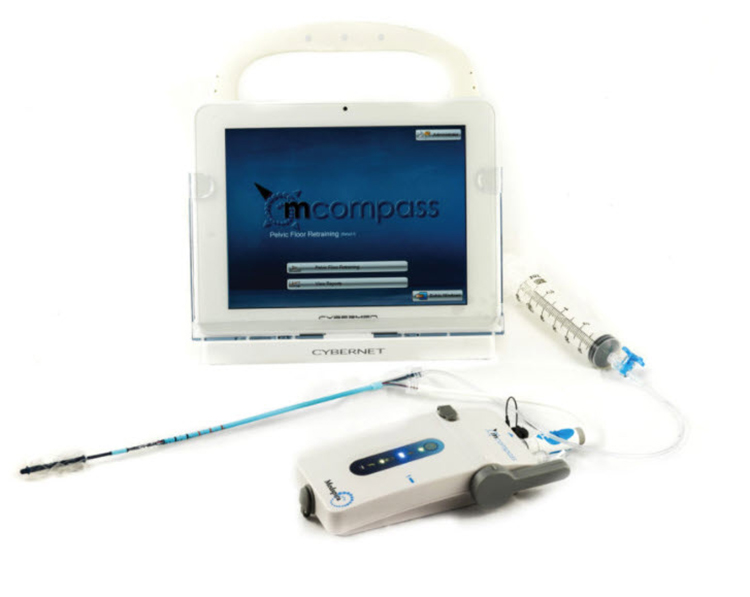
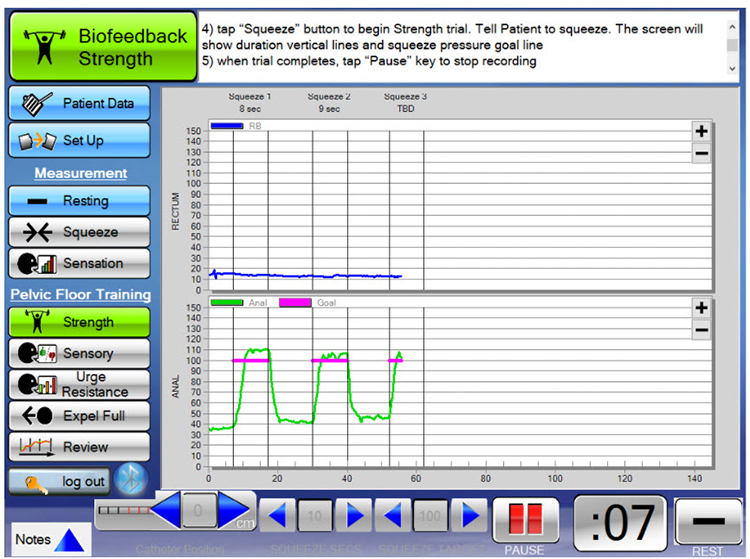
Clinical Efficacy
Women
Based on 20 RCTs, Meehan and Shaffer (2023) rated biofeedback for urinary incontinence in women as level 5 - efficacious and specific in Evidence-Based Practice in Biofeedback and Neurofeedback (4th ed.). Several demonstrated the superiority of biofeedback for urinary incontinence in women to credible treatments in at least two independent research setting.The National Health Technology Assessment (NHTA) report by Imamura et al. (2010) of 55 trials involving 6608 women found that pelvic floor muscle training combined with biofeedback was effective. A Cochrane Review by Herderschee et al. (2011) of 24 trials involving 1583 women found that patients who received biofeedback reported higher remission rates or improvement than those who only received pelvic-floor muscle training (PMFT). These findings may have been biased by more extensive contact with health professionals.
Men
Based on 21 RCTs, Meehan and Shaffer (2023) rated biofeedback for urinary incontinence in men as level 5 - efficacious and specific in Evidence-Based Practice in Biofeedback and Neurofeedback (4th ed.). Most studies involved men who underwent prostatectomy (removal of the prostate).They reviewed 21 RCTs. Several demonstrated the superiority of biofeedback for urinary incontinence in men to credible treatments in at least two independent research setting.Children
Based on 5 RCTs, Meehan and Shaffer (2023) rated biofeedback for urinary incontinence in children as level 4 - efficacious in Evidence-Based Practice in Biofeedback and Neurofeedback (4th ed.). Limited RCTs, including dysfunctional voiding (which can be independent of UI), and methodological inconsistency, precluded a higher rating.MENISCECTOMY
After removing meniscus cartilage in the knee, a post meniscectomy patient experiences weakness in the muscles that act on the leg.
Listen to a mini-lecture on Meniscectomy © BioSource Software LLC.
A knee joint is shown below with cartilage and tendons. Graphic © joshya/ Shutterstock.com.
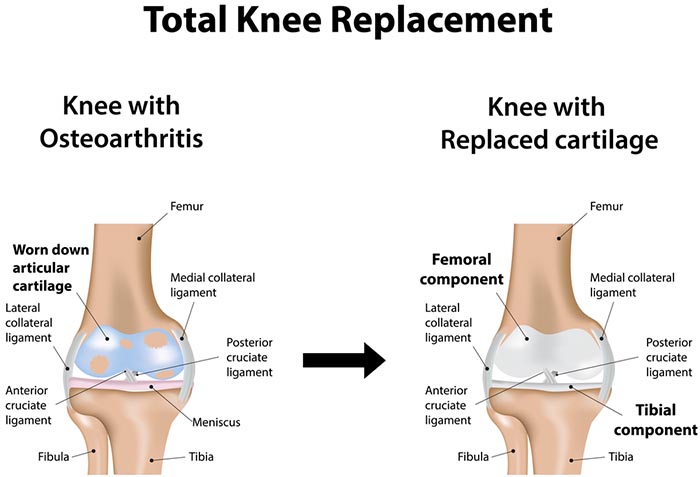
Demographics
Acute meniscal tears are diagnosed in 61 of 100,000 persons in the United States. Males outnumber females 2.5 to 1. Meniscal injury shows the highest incidence in males 31-40 and females 11-20. The rate of this problem is 60% in patients above the age of 65 (Baker, 2014).Biofeedback Protocols
SEMG electrodes may be placed over the quadriceps femoris to assist in practicing isometric or isotonic contractions to increase muscle strength. Due to weak muscle output, the initial electrode spacing should be wide and narrowed to reduce crosstalk from co-contracting hamstring muscles. The Mind Media EXG sensor below can detect two channels of SEMG activity.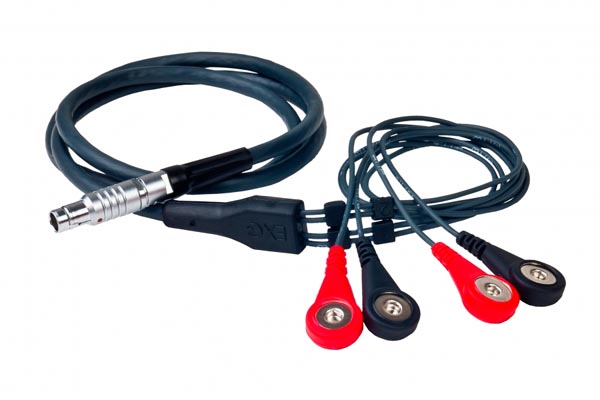
The Thought Technology Ltd. MyOnyx system combines two EMG channels with electrical stimulation.
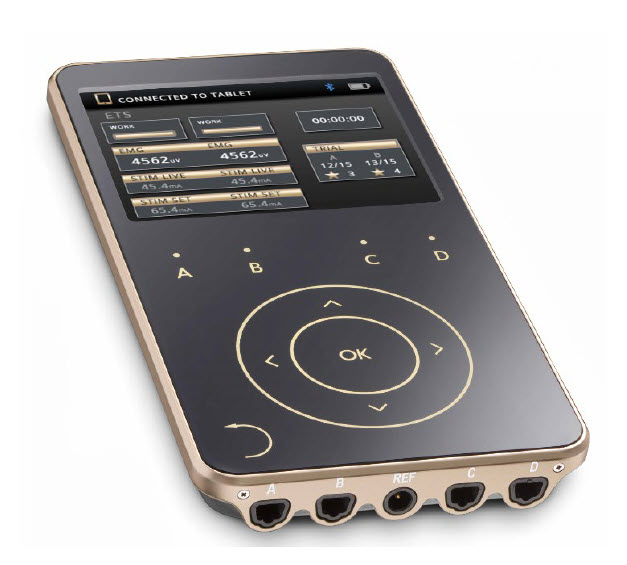
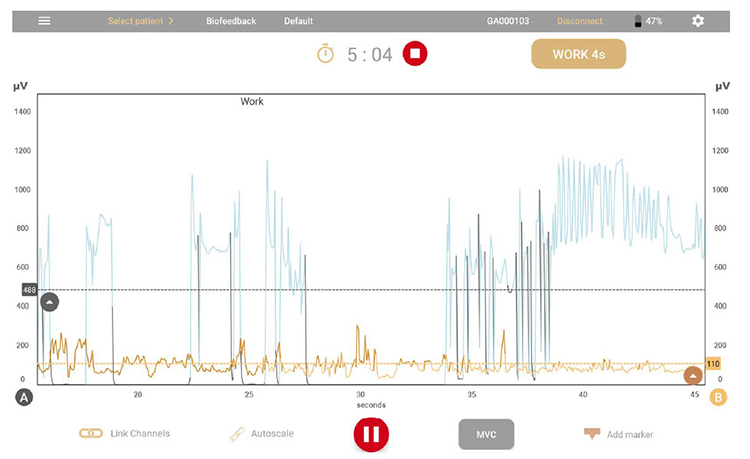
The vastus lateralis and vastus medialis, which are trained following meniscectomy, are shown below. The graphic © design36/Shutterstock.com.
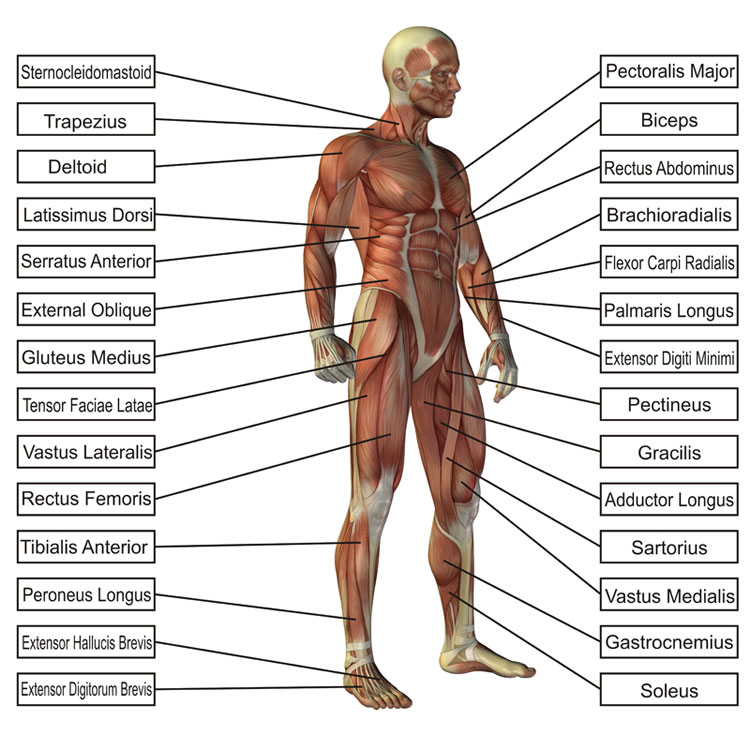
Total knee arthroplasty (TKA) treats knee pain, deformity, and instability due to degeneration or inflammation by replacing the knee with a prosthesis. Pain due to severe arthritis is the primary indication for this procedure. Physical therapy is initiated soon after surgery and involves exercises that may complement a continuous passive motion (CPM) device. Patients must usually achieve 90-degree knee flexion before discharge (Palmer & Cross, 2004). Graphic © Tridsanu Thopet/ Shutterstock.com.
Demographics
In 2009, total knee replacement surgeries exceeded 600,000, double the previous decade's number. In 2012, 4.5 million Americans lived with a total knee replacement of at least one knee. The frequency exceeded 5% for women and about 4% for men over 50 (ABC News, 2012).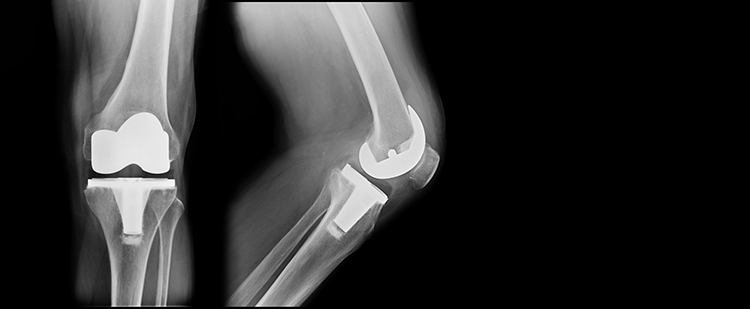
Biofeedback Studies
Click on the Read More button to see research study summaries.

Kuiken, Amir, and Scheidt (2004) studied 14 asymptomatic controls and 11 patients following total knee arthroplasty (TKA), in which the knee joint was surgically replaced. A computerized biofeedback knee joint goniometer (CBG) provides patients and physicians with audiovisual feedback about knee joint angle. This information is crucial in retraining TKA patients to achieve a normal range of motion (ROM). The authors reported that CBG-angle measurements were highly correlated with manual clinician measurements between 0 and 100 degrees. Most patients showed good acceptance of CBG. Auditory feedback motivated exercise more than visual feedback. There was slightly more ROM activity on days that the device silently monitored patients than on the audiovisual feedback days.
Akaya et al. (2012) performed a randomized controlled trial of 45 partial meniscectomy patients that compared home exercise, EMG biofeedback with home exercise, and electrical stimulation therapy for the quadriceps with home exercise. The group that received EMG biofeedback with home exercise was superior to the home exercise alone group on time using a walking aid and on Lysholm Knee Scoring Scale scores. The group that received EMG biofeedback was also superior to the other two groups on the maximum and average contraction of the vastus medialis obliquus and vastus lateralis muscles in the second week following surgery.
Oravitan and Avram (2013) conducted a randomized controlled trial of 64 patients who underwent meniscal sutures. Thirty-three patients received SEMG biofeedback in addition to physical therapy, and 31 patients only received physical therapy. At 8 weeks after surgery, the group who received SEMG biofeedback and physical therapy increased SEMG amplitudes and muscle contraction and relaxation speed. Their Knee injury and Osteoarthritis Outcome Score (KOOS) values were higher than the control group, and this difference predicted greater capacity for recreational and sports activities. However, their thigh muscle strength, daily activities, pain, and other symptoms did not differ from the control group.
Clinical Efficacy
Evidence-Based Practice in Biofeedback and Neurofeedback (4th ed.) did not evaluate this application.MUSCLE-TENDON TRANSFER
Muscle-tendon transfer is a procedure that repositions a tendon so that an attached muscle can be reoriented and produce a new movement. This operation is used when there is permanent muscle injury or paralysis and is designed to replace or reconstruct a missing motor function (Baumeister, 2013).
Listen to a mini-lecture on Muscle-Tendon Transfer © BioSource Software LLC.
Biofeedback Protocols
SEMG biofeedback increases motor unit recruitment in re-educated muscles and reduces interference from antagonist muscles. Where SEMG measurements do not correspond to a change in position, as when the recording surface (wrist) is too small for electrodes or the muscle lies too deeply, positional feedback may be superior. For example, a Thought Technology Ltd. electrogoniometer (shown below) places a potentiometer over two bones that form a joint and displays 180 degrees of joint angle changes as changes in voltage.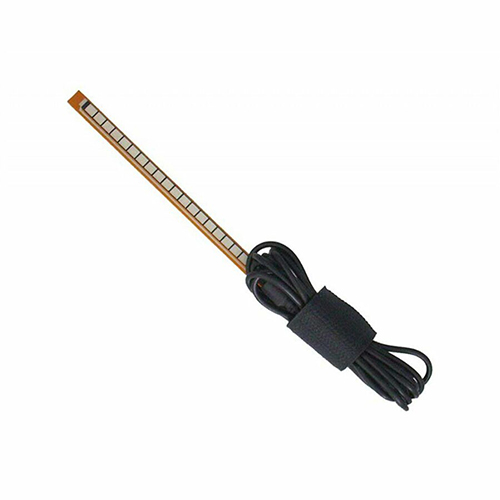
A Biometrics Ltd. dual-axis electrogoniometer (shown below) aids in the analysis of a joint's range of motion.
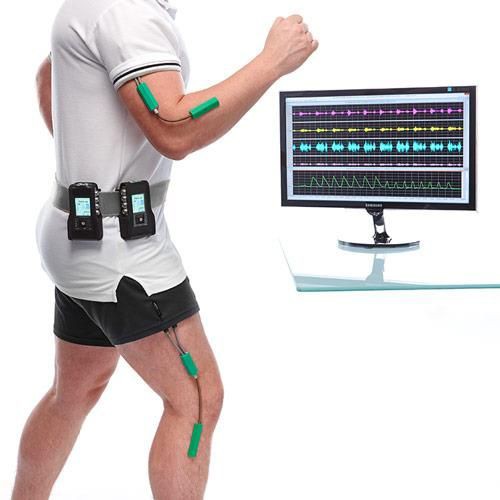
Clinical Efficacy
Evidence-Based Practice in Biofeedback and Neurofeedback (4th ed.) did not evaluate this application.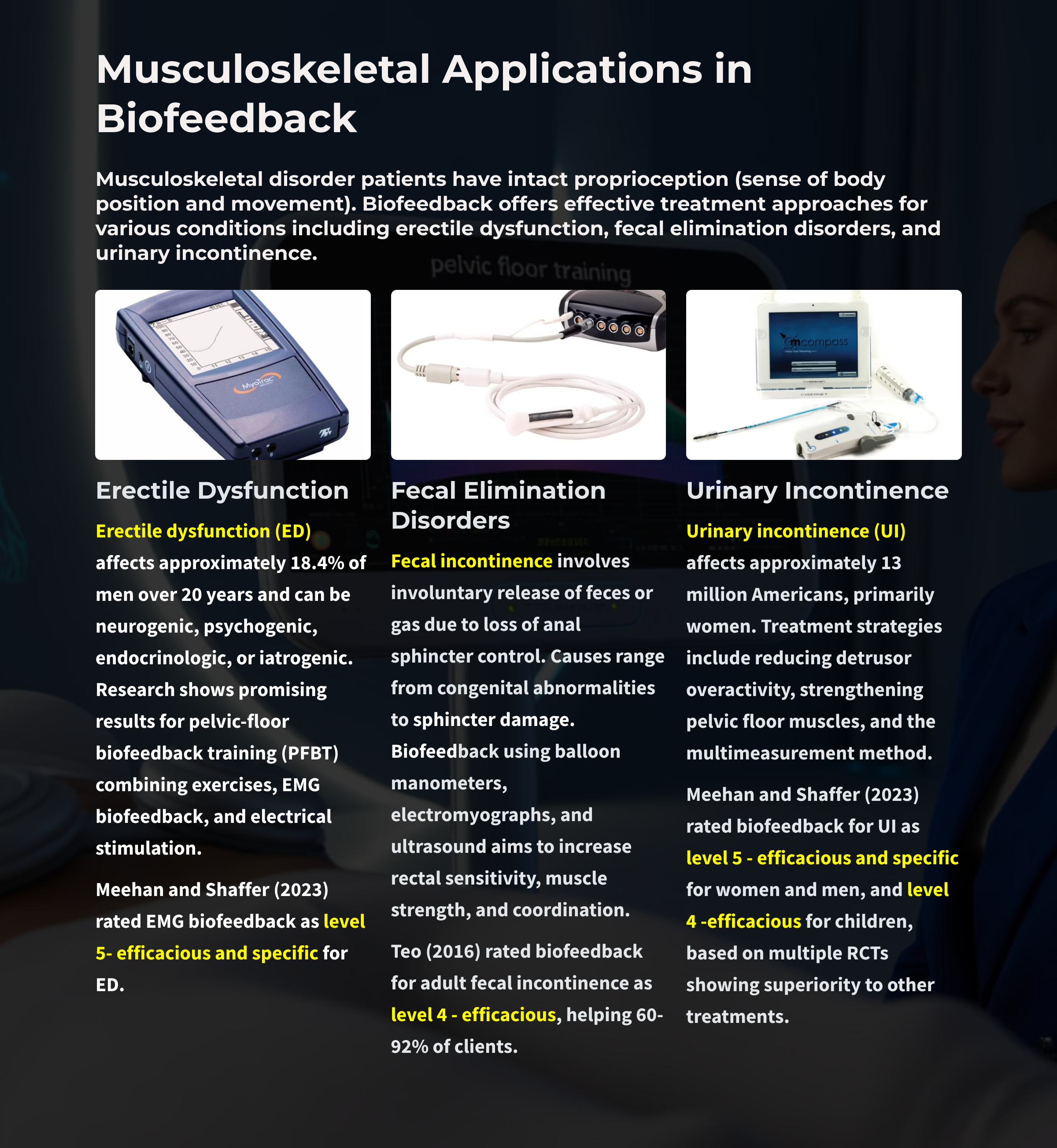
Glossary
anal EMG probe: an internal EMG electrode, which consists of two active electrodes inserted in the rectum and an external reference electrode to measure and train pelvic floor muscles (PFM).
blepharospasm: spasms of the eyelids characterized by bilateral blinking that results in symptoms that range in severity from increased blinking and periodic eyelid spasm to ocular pain, facial spasms, and disabling interference with vision.
computerized biofeedback knee joint goniometer (CBG): a biofeedback instrument that provides patients and physicians with audiovisual feedback about knee joint angle. This information is crucial in retraining total knee arthroplasty (TKA) patients to achieve a normal range of motion (ROM).
defecation reflex: pressure on the rectal wall triggers the firing of sacral spine parasympathetic motor neurons that shortens the rectum, increasing pressure on fecal material and the internal anal sphincter, which involuntarily relaxes in response to parasympathetic stimulation, voluntary diaphragm, and abdominal muscle contraction, and pressure.
detrusor muscle: the intermediate coat of the urinary bladder, composed of three smooth muscle layers.
dyssynergic defecation: difficulty evacuating stools.
electrogoniometer: an electronic device that measures the range of motion (ROM) by placing a potentiometer over the two bones that form a joint and converting voltage changes into changes in joint angle.
erectile dysfunction (ED): the inability to either achieve or maintain an erection that will permit acceptable sexual performance.
external anal sphincter (sphincter ani externus): an elliptically-shaped voluntary muscle tonically contracted to close the anal canal and orifice. Relaxation of this muscle expels feces, while constriction postpones defecation.
external urethral sphincter: the voluntary ring of skeletal muscle, located at the distal aspect of the bladder in females and below the prostate in males, controls urine flow through the urethra. Relaxation of this muscle allows urination, while contraction postpones it.
fecal incontinence: the involuntary release of feces or gas due to loss of anal sphincter control.
internal anal sphincter (sphincter ani internus): the muscular ring of involuntary muscle. Relaxation of this muscle helps the external anal sphincter expel feces, while contraction postpones defecation.
internal urethral sphincter: an involuntary ring of smooth muscle around the urethra’s opening controlled by parasympathetic fibers. Relaxation of this muscle allows urination, while contraction postpones it.
manometry system: an anorectal probe that places one of three balloons in the anal canal to simulate the movement of fecal material. The second balloon is adjacent to the internal rectal sphincter, and the third is adjacent to the external rectal sphincter. As the anal canal balloon is inflated, the software displays the contraction of the internal and external rectal sphincters.
meniscectomy: the surgical removal of torn knee fibrocartilage.
micturition center: located in segments S2 and S3 of the sacral spinal cord, it triggers the micturition reflex following the arrival of signals from bladder wall stretch receptors.
micturition reflex: when bladder volume exceeds 200-400 milliliters, the micturition center signals the detrusor muscle to contract and the internal urethral sphincter to relax and blocks contraction of the external urethral sphincter, causing it to relax.
mixed incontinence: the involuntary loss of urine that results from stress and urge incontinence. The detrusor is overactive, and the urinary sphincters are weak.
muscle-tendon transfer: a surgical procedure that repositions a tendon so that an attached muscle can be reoriented and produce a new movement when there is permanent muscle injury or paralysis.
orbicularis oculi: the facial muscle that closes the eyelids and wrinkles the forehead. Flaccid paralysis of this muscle occurs in Bell's palsy, and spasm produces blepharospasm.
overflow incontinence: urinary incontinence due to urethral blockage.
post meniscectomy patient: an individual who has had torn knee fibrocartilage removed.
prostatectomy: the removal of the prostate.
quadriceps femoris: the great leg extensor composite muscle consists of the rectus femoris, vastus lateralis, vastus medialis, and vastus intermedius. This muscle is up-trained following meniscectomy and total knee arthroplasty (TKA).
rectus femoris: a component of the quadriceps femoris located on the anterior thigh that extends the leg at the knee joint and flexes the thigh at the hip joint.
slow transit constipation: the slow movement of feces through the colon.
stress incontinence: the involuntary loss of a variable amount of urine when intra-abdominal pressure increases. The problem is the failure of the urethral sphincters to resist urinary flow that is possibly caused by excessive urethral movement due to insufficient pelvic floor support and intrinsic sphincter deficiency.
total knee arthroplasty (TKA): the replacement of the knee with a prosthesis.
urge incontinence: involuntarily emptying the entire bladder produced by detrusor muscle overactivity due to detrusor myopathy (an abnormal muscle condition), neuropathy (nerve damage), and both myopathy and neuropathy.
urinary bladder: a hollow, muscular, elastic organ located in the pelvic cavity that collects urine from the ureters and stores it for release through the urethra.
urinary incontinence: the involuntary loss of urine divided into urge incontinence, stress incontinence, and mixed incontinence.
vastus lateralis: a component of the quadriceps femoris located on the lateral thigh that extends the leg at the knee joint.
vastus medialis: a component of the quadriceps femoris located on the medial thigh that extends the leg at the knee joint.
Test Yourself
Click on the ClassMarker logo to take 10-question tests over this unit without an exam password.

REVIEW FLASHCARDS ON QUIZLET
Click on the Quizlet logo to review our chapter flashcards.

Visit the BioSource Software Website
BioSource Software offers Human Physiology, which satisfies BCIA's Human Anatomy and Physiology requirement, and Biofeedback100, which provides extensive multiple-choice testing over BCIA's Biofeedback Blueprint.

Assignment
Now that you have completed this module, consider the conditions where muscle activity should be decreased or increased.
References
Baker, B. S. (2014). Meniscus injuries. eMedicine.
Basmajian, J. V. (Ed.). (1989). Biofeedback: Principles and practice for
clinicians. Williams & Wilkins.
Basson, M. D. (2015). Constipation. eMedicine.
Bassotti, G., Chistolini, F., Sietchiping-Nzepa, F., de Roberto, G., Morelli, A., & Chiarioni, G. (2004). Biofeedback for pelvic floor dysfunction in constipation. BMJ, 328(7436), 393-396. https://dx.doi.org/10.1136%2Fbmj.328.7436.393
Baumeister, S. (2013). Hand tendon transfers. eMedicine.
Benet, A. E., & Melman, A. (1995). The epidemiology of erectile dysfunction. Urol Clin North Am, 22(4), 699-709. https://doi.org/10.1016/S0094-0143(21)00690-X
Bleijenberg, G., & Kuijpers, H. C. (1994). Biofeedback treatment of constipation: A comparison of two methods. The American Journal of Gastroenterology, 89(7), 1021-1026. PMID: 8017359
Burnett, A. L., Aus, G., Canby-Hagino, E. D., Cookson, M. S., D’Amico, A. V., Dmochowski, R. R., . . .
Thompson, I. (2007). Erectile function outcome reporting after clinically localized prostate cancer
treatment. J Urol, 178(2), 597-601. https://doi.org/10.1016/j.juro.2007.03.14
Byrne, C. M., Solomon, M. J., Young, J. M., Rex, J., & Merlino, C. L. (2007). Biofeedback for fecal incontinence: short-term outcomes of 513 consecutive patients and predictors of successful treatment. Dis
Colon Rectum, 50(4), 417-427. https://doi.org/10.1007/s10350-006-0846-1
Combs, A. J., Glassberg, A. D., Gerdes, D., & Horowitz, M. (1998).
Biofeedback therapy for children with dysfunctional voiding. Urology,
52(2), 312-315. https://doi.org/10.1016/s0090-4295(98)00189-7
Cram, J. R., & associates (1990). Clinical EMG for surface recordings:
Volume 2. Clinical Resources.
Dorey, G., Speakman, M., Feneley, R., Swinkels, A., Dunn, C., & Ewings, P. (2004). Pelvic floor exercises
for treating post-micturition dribble in men with erectile dysfunction: A randomized controlled
trial. Urol Nurs, 24(6), 490-497, 512.
Dorey, G., Speakman, M. J., Feneley, R. C., Swinkels, A., & Dunn, C. D. (2005). Pelvic floor exercises for
erectile dysfunction. NJU Int, 96(4), 595-597. https://doi.org/10.1111/j.1464-410X.2005.05690.x
Dubbleman, Y. D., Dohle, G. R., & Schröder, F. H. (2006). Sexual function before and after radical
retropubic prostatectomy: A systematic review of prognostic indicators for a successful outcome.
Eur Urol, 50(4), 711-718. https://doi.org/10.1016/j.eururo.2006.06.009
Durmus, D., Alayli, G., & Canturk, F. (2007). Effects of quadriceps electrical stimulation program on clinical parameters in the patients with knee osteoarthritis. Clin
Rheumatol, 26(5), 674-678. https://doi.org/10.1007/s10067-006-0358-3
Enck, P., Van der Voort, I. R., & Klosterhalfen, S. (2009). Biofeedback therapy in fecal incontinence and constipation. Neurogastroenterology & Motility, 21(11), 1133-1141. https://doi.org/10.1111/j.1365-2982.2009.01345.x
Floratos, D. L., Sonke, G. S., Rapidou, C. A., Alivizatos, G. J.,
Deliveliotis, C., Constantinides, C. A., et al. (2002). Biofeedback vs. verbal feedback as learning tools for pelvic muscle exercises in the early management of urinary incontinence after radical prostatectomy.
British Journal of Urology, International, 89(7), 714-719. https://doi.org/10.1046/j.1464-410x.2002.02721.
Gann, C. (2012). Knee replacements double in 10 years, study says. ABC News.
Gevirtz, R. (2003). The mind/muscle connection: A search for
psychophysiological mechanisms of chronic muscle pain. Special Address
presented at the 34th AAPB annual convention at Jacksonville, Florida.
Gibbons,
C. H., & Engstrom, J. W. (2018). Disorders of the autonomic nervous system. In D. L. Kasper, A. S. Fauci, S. L. Hauser, D. L. Longo, J. L. Jameson, & J. Loscal (Eds.). Harrison's principles of internal medicine 20/E (Vol. 1 & Vol. 2) (20th ed.). McGraw-Hill Professional.
Gilliland, R., Heymen, S., Altomare, D. F., Park, U. C., Vickers, D., & Wexner, S. D. (1997). Outcome and predictors of success of biofeedback for constipation. British Journal of Surgery, 84(8), 1123-1126. PMID: 9278659
Glazer, H. I., Laine, C. D. (2006). Pelvic floor muscle biofeedback in the treatment of urinary incontinence: A literature review. Applied
Psychophysiology and Biofeedback, 31(3), 187-201. https://doi.org/10.1007/s10484-006-9010-x
Graham, R. H. (2014). Benign essential blepharospasm. eMedicine.
Hartje, J. (1997). Biofeedback: Basic neuromuscular
intervention (module 3). Association for Applied Psychophysiology and Biofeedback.
Herderschee, R., Hay-Smith, E. J., Herbison, G. P., Roovers, J. P., & Heineman, M. J. (2011).
Feedback or biofeedback to augment pelvic floor muscle training for urinary incontinence in women. Cochrane Database Syst Rev, (7), CD00952. https://doi.org/10.1002/14651858.CD009252
Heymen, S., Jones, K. R., Ringel, Y., Scarlett, Y., & Whitehead, W. E.
(2001). Biofeedback treatment of fecal incontinence: A critical review. Diseases of the Colon and
Rectum, 44(5), 728-736. https://doi.org/10.1007/BF02234575
Hoekx, L., Wyndaele, J. J., & Vermandel, A. (1998). The role of bladder biofeedback in the treatment of children with refractory nocturnal enuresis associated with idiopathic detrusor instability and small bladder capacity. Journal of Urology, 160 (3 pt 1), 858-860. https://doi.org/10.1097/00005392-199809010-00077
Imamura, M., Abrams, P., Bain, C., Buckley, B., Cardozo, L., Cody, J., Cook, J., Eustice, S., Glazener, C., Grant, A., Hay-Smith, J., Hislop, J., Jenkinson, D., Kilonzo, M., Nabi, G., N'Dow, J., Pickard, R., Ternent, L., Wallace, S., Wardle, J, Zhu, S., & Vale, L. (2010). Systematic review and economic modeling of the effectiveness and cost-effectiveness of non-surgical treatments for women with stress urinary incontinence. Health Technol Assess, 14(40, 1-88, iii-iv. https://doi.org/10.3310/hta14400
Kim, E. D. (2015). Erectile dysfunction. eMedicine.
Koh, C. E., Young, C. J., Young. J. M., & Solomon, M. J. (2008). Systematic review of randomized controlled trials of the effectiveness of biofeedback for pelvic floor dysfunction. Br
J Surg, 95(9), 1079-1087. https://doi.org/10.1002/bjs.6303
Kuiken, T. A., Amir, H., & Scheidt, R. A. (2004). Computerized biofeedback knee goniometer: Acceptance and effect on exercise behavior in post-total knee arthroplasty rehabilitation. Archives of Physical
Medicine Rehabilitation, 85(6), 1026-1030. https://doi.org/10.1016/j.apmr.2003.08.088
McKenna, P. H., Herndon, C. D., Connery, S., & Ferrer, F. A. (1999).
Pelvic floor muscle retraining for pediatric voiding dysfunction using interactive computer games. Journal of Urology, 162(3 pt 2),
1056-1063. PMID: 10458431
Mahony, R. T., Malone, P. A., Nalty, J., Behan, M., O'Connell, P.
R., & O'Herlihy, C. (2004). Randomized clinical trial of intra-anal electromyographic biofeedback physiotherapy with intra-anal electromyographic biofeedback augmented with electrical stimulation of the anal sphincter in the early treatment of postpartum fecal incontinence. American Journal of Obstetrics and Gynecology, 191(3),
885-890. https://doi.org/10.1016/j.ajog.2004.07.006
Meehan, Z. M., Shaffer, F., & Zerr, C. L. (2023). Erectile dysfunction. In I. Khazan, F. Shaffer, D. Moss, R. Lyle, & S. Rosenthal (Eds). Evidence-based practice in biofeedback and neurofeedback (4th ed.). Association for Applied Psychophysiology and Biofeedback.
Meehan, Z. M., Shaffer, F., & Zerr, C. L. (2023). Urinary incontience in adult men. In I. Khazan, F. Shaffer, D. Moss, R. Lyle, & S. Rosenthal (Eds). Evidence-based practice in biofeedback and neurofeedback (4th ed.). Association for Applied Psychophysiology and Biofeedback.
Meehan, Z. M., Shaffer, F., & Zerr, C. L. (2023). Urinary incontience in adult women. In I. Khazan, F. Shaffer, D. Moss, R. Lyle, & S. Rosenthal (Eds). Evidence-based practice in biofeedback and neurofeedback (4th ed.). Association for Applied Psychophysiology and Biofeedback.
Meehan, Z. M., Shaffer, F., & Zerr, C. L. (2023). Urinary incontience in children. In I. Khazan, F. Shaffer, D. Moss, R. Lyle, & S. Rosenthal (Eds). Evidence-based practice in biofeedback and neurofeedback (4th ed.). Association for Applied Psychophysiology and Biofeedback.
Nelson, R., Norton, N., Cautley, E., & Furner, S. (1995). Community-based prevalence of anal incontinence. JAMA,
274(7), 559-561. https://doi.org/10.1001/jama.1995.03530070057030
Norton, C., Cody, J. D., & Hosker, G. (2006). Biofeedback and/or sphincter exercises for the treatment of faecal incontinence in adults. Cochrane
Database Syst Rev, (3), CD002111. https://doi.org/10.1002/14651858.CD002111.pub3
Oravitan, M., & Avram, C. (2013). The effectiveness of electromyographic biofeedback as part of a meniscal repair rehabilitation programme. J Sports Sci Med, 12(3), 526-532. PMCID: PMC3772598
Prota, C., Gomes, C. M., Ribeiro, L. H., de Bessa Jr, J., Nakano, E., Dall’Oglio, M., Bruschini, H., & Srougi, M. (2012).
Early postoperative pelvic-floor biofeedback improves erectile function in men undergoing radical
prostatectomy: A prospective, randomized, controlled trial. International Journal of Impotence
Research, 24(5), 174-178. https://doi.org/10.1038/ijir.2012.11
Ranganath, S. (2012). Fecal incontinence. eMedicine.
Rao, S. S., Seaton, K., Miller, M., Brown, K., Nygaard, I., Stumbo, P., Zimmerman, B., & Schultze, K. (2007). Randomized controlled trial of biofeedback, sham feedback, and standard therapy for dyssynergic defecation. Clin
Gastroenterol Hepatol, 5(3), 331-338. https://doi.org/10.1016/j.cgh.2006.12.023
Remes-Troche, J. M., & Rao, S. S. (2006). Defecation disorders: Neuromuscular aspects and treatment. Curr
Gastroenterol Rep, 8(4), 291-299. https://doi.org/10.1007/s11894-006-0049-x
Sighinolfi, M. C., Rivalta, M., Mofferdin, A., Micali, S., De Stefani, S., & Bianchi, G. (2009). Potential
effectiveness of pelvic floor rehabilitation treatment for post radical prostatectomy incontinence,
climacturia, and erectile dysfunction: A case series. J Sex Med, 6(12), 3496–3499. doi:
https://doi.org/10.1111/j.1743-6109.2009.01493.x
Solomon, M. J., Pager, C. K., Rex, J., Roberts, R., & Manning, J. (2003). Randomized, controlled trial of biofeedback with anal manometry, transanal ultrasound, or pelvic floor retraining with digital guidance alone in the treatment of mild to moderate fecal incontinence. Diseases of the colon & rectum, 46(6), 703-710. https://doi.org/10.1007/s10350-004-6643-9
Teo, I. (2016). Fecal incontinence. In G. Tan, F. Shaffer, R. R. Lyle, & I. Teo (Eds.). Evidence-based practice in biofeedback and neurofeedback (3rd ed.). Wheat Ridge: AAPB.
Teo, I. (2016). Functional constipation. In G. Tan, F. Shaffer, R. R. Lyle, & I. Teo (Eds.). Evidence-based practice in biofeedback and neurofeedback (3rd ed.). Association for Applied Psychophysiology and Biofeedback.
Teunissen, T. A., de Jonge, A., van Wheel, C., & Lagro-Jannsen, A. L. (2004). Treating urinary incontinence in the elderly -- conservative therapies that work: A systematic review. The
Journal of Family Practice, 53(1), 25-30, 32. PMID: 14709263
Tries, J., & Brubaker, L. (1996). Application of biofeedback in the
treatment of urinary incontinence. Professional Psychology: Research
and Practice, 27(6), 554-560. https://doi.org/10.1037/0735-7028.27.6.554
Tries, J., Eisman, E., & Lowery, S. P. (1995). Fecal incontinence. In M.
S.
Schwartz (Ed.). Biofeedback: A practitioner's guide.
The Guilford Press.
Van Kampen, M. De Weerdt, W., Van Poppel, H., De Ridder, D., Feys, H., &
Baert, L. (2000). Effect of pelvic floor re-education on duration and degree of incontinence after radical prostatectomy: A randomized controlled trial. Lancet, 355(9198), 98-102. https://doi.org/10.1016/S0140-6736(99)03473-X
Vasavada, S. P. (2014). Urinary incontinence. eMedicine.
Vonthein, R., Heimerl, T., Schwandner, T., & Ziegler, A. (2013). Electrical stimulation and biofeedback for the treatment of fecal incontinence: a systematic review. International journal of colorectal disease, 28(11), 1567-1577. https://doi.org/10.1007/s00384-013-1739-0
Wallace, S. A., Roe, B., Williams, K., & Palmer, M. (2004). Bladder training for urinary incontinence in adults. Cochrane
Database of Systematic Reviews (Online), 1(1), CD001308. https://doi.org/10.1002/14651858.CD001308.pub2
Walsh, P. C., Epstein, J. I., & Lowe, F. C. (1987). Potency following radical prostatectomy with wide
unilateral excision of the neurovascular bundle. J Urol, 138(4), 823-827. https://doi.org/10.1016/s0022-5347(17)43385-4
Wang, A. C., Wang, Y. Y., & Chen, M. C. (2004). Single-blind, randomized trial of pelvic floor muscle training, biofeedback-assisted pelvic floor muscle training, and electrical stimulation in the management of overactive bladder. Urology, 63(1), 61-66. https://doi.org/10.1016/j.urology.2003.08.047
Whitehead, W. E., & Drossman, D. A. (1996). Biofeedback for disorders of
elimination: Fecal incontinence and pelvic floor dyssynergia.
Professional Psychology: Research and Practice, 27(3), 234-240. https://doi.org/10.1037/0735-7028.27.3.234
Woodward, S., Norton, C., & Chiarelli, P. (2014). Biofeedback for treatment of chronic idiopathic constipation in adults. Cochrane Database of Systematic Reviews, 3. https://doi.org/10.1002/14651858.CD008486.pub2